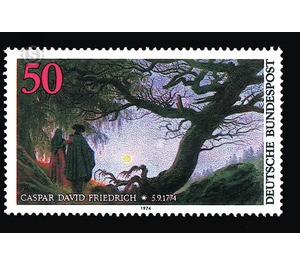200th birthday of Caspar David Friedrich - Germany / Federal Republic of Germany 1974 - 50 Pfennig
Theme: Art & Culture
| Country | Germany / Federal Republic of Germany |
| Issue Date | 1974 |
| Face Value | 50.00 |
| Color | multi-colored |
| Perforation | K 13 3/4: 14 |
| Printing Type | 4-color rotogravure |
| Stamp Type | Postage stamp |
| Item Type | Stamp |
| Chronological Issue Number | 704 |
| Chronological Chapter | GER-BRD |
| SID | 701104 |
| In 75 Wishlists | |
The romantic landscape painter and draftsman Caspar David Friedrich was born on 5 September 1774 in Greifswald and died on 7 May 1840 in Dresden. He received his education in Greifswald and in 4 years at the Academy Copenhagen. Crucial for his work were traveling to Rügen, Bohemia, the Giant Mountains and the Harz. At first he limited himself to drawing and sepia and watercolor painting in the sentimental-idyllic taste of the 18th century. Only since 1807 he devoted himself to oil painting. His art of drawing, which generously and simply captured landscapes and objects, he combined with delicate and rich, later heavier color to moody representation of nature in the light of the seasons and the passing and transience. He became the creator of landscape painting in religious symbolic meaning.


